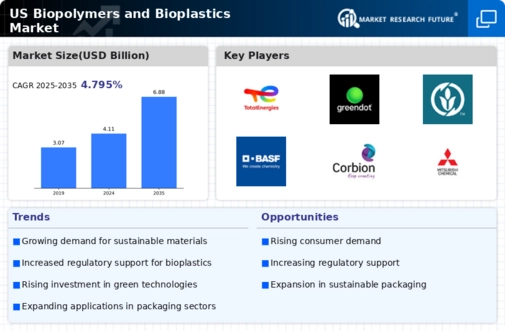The competitive landscape of the US Biopolymers and Bioplastics Market is shaped by a growing emphasis on sustainable and environmentally friendly alternatives to traditional plastics. As the demand for bioplastic materials increases among consumers and industries alike, several key players are striving to innovate and capture market share. This sector benefits from rising environmental concerns, government regulations promoting sustainable practices, and advancements in technology that facilitate the development of biodegradable and compostable materials. Companies in this market are constantly exploring strategic partnerships, investments in research and development, and enhancements in production techniques to boost their competitive edge.
The dynamic landscape is characterized by players diversifying their product lines to meet the evolving needs of various applications, including packaging, automotive, and consumer products.
TotalEnergies
TotalEnergies has established a strong foothold in the US Biopolymers and Bioplastics Market, leveraging its diverse capabilities in energy production and materials technology. The company emphasizes a commitment to sustainable development, striving to provide innovative biopolymer solutions that contribute to reducing plastic waste and carbon footprint. TotalEnergies benefits from its extensive supply chain and integrated business model, which allows for effective management of resources and optimized production processes. By investing in cutting-edge research and developing partnerships within the biopolymer ecosystem, TotalEnergies is well-positioned to address the unique challenges and opportunities present within this rapidly evolving market.
The company maintains a focus on expanding its presence in bioplastics, aligning its products with sustainability goals set by various industries across the United States.
Green Dot
Green Dot has made significant strides in the US Biopolymers and Bioplastics Market, primarily through its innovative product offerings and commitment to sustainability. The company specializes in producing biobased materials and has gained recognition for developing compostable products that meet the growing demand for environmentally friendly solutions. Green Dot's market presence is reinforced by its ability to cater to various applications, including packaging and single-use items. In recent years, the company has actively pursued strategic mergers and acquisitions to enhance its product portfolio and expand its production capabilities.
This approach has enabled Green Dot to strengthen its competitive positioning while fostering collaborations with other key players in the biopolymer space. Their continuous focus on research and development ensures that they remain at the forefront of innovation, positioning them as critical contributors to a more sustainable plastic landscape in the US.























Leave a Comment